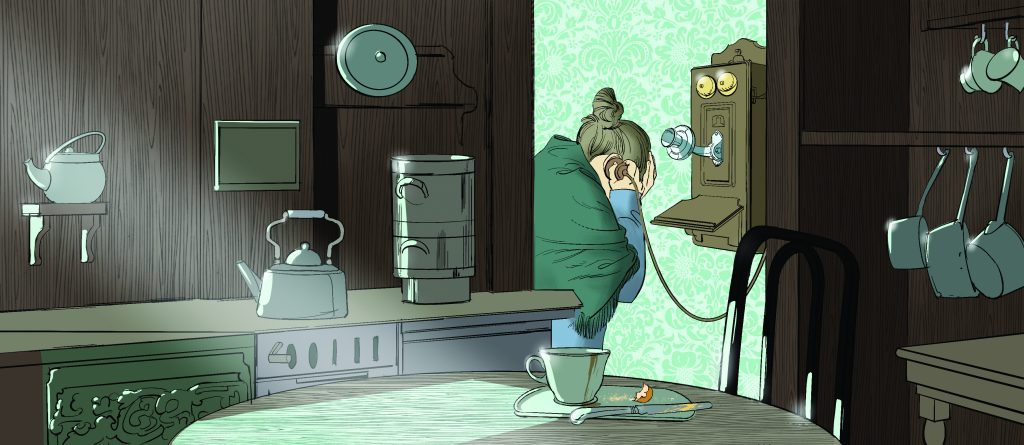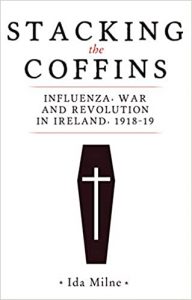Legacy of the 1918 influenza pandemic

Colin Kerr
Published: Thursday, December 31, 2020
 In Stacking The Coffins - Influenza, War and Revolution in Ireland, 1918-19 (Manchester University Press), Dr Ida Milne, a historian of disease and European history lecturer at Carlow College, Ireland, tells the story of the 1918-1919 influenza pandemic which killed more than 50 million people and infected between one fifth and half of the world’s population.
While Dr Milne’s book focuses on the effect of the pandemic in Ireland, she also gives an overview of the influenza outbreak globally.
The outbreak of the pandemic came at the end of the First World War. Dr Milne, in the opening chapter of the book notes that the newspapers of the day flagged it as a “mysterious disease”, “a mysterious malady”. The pandemic disrupted the Paris Peace Conference, after delegations charged with negotiating a lasting peace, were affected by the mystery flu and in early spring 1918, doctors paid 125 house calls in one day to the American delegation.
Dr Milne quotes a passage from Alfred Crosby’s American Forgotten Pandemic (1976) which states: “The most important and almost incomprehensible fact about the Spanish flu is that it killed millions of people in a year or less. Nothing less – no infection, no war, no famine – has ever killed so many in such a short period. And yet it has never inspired awe, not in 1918 and not since, not among the citizens of the United States”.
The final global death toll was more than 50 million people but as Dr Milne notes death registration was rudimentary in many parts of the world so the final number of mortalities will never be known.
This short article cannot do justice to Dr Milne’s book so I will focus briefly on Chapter 5 which deals with the doctor’s view of the disease. As Dr Milne notes, even today diagnosing influenza poses difficulties. The 1918 ailment could be a mild disease in some people with sore throat, fever and aches. In other cases, it could lead to death within a matter of hours.
“A man could rise from bed, have his breakfast and leave for work. By lunchtime his wife could be informed that he had died,” says Dr Milne.
Dr Milne also notes that some patients recovered from the influenza attack and resumed normal life but died from post-influenza pneumonia, heart attacks caused by the illness or other complications. The disease damaged the heart and lungs in some cases and could also cause various types of nerve, eye and ear disorders. The cranial nerves could also be affected leading to disturbed or temporary loss of smell. Ophthalmologists will also be interested to note that inflammation or atrophy of the nerves in the eye and ocular palsies occurred among some of those who were treated for the new strain of influenza.
As Dr Milne concludes at the end of this excellent book, the 1918-1919 pandemic has legacies that still endure. This book is essential reading for ophthalmologists and other health professionals.
* Colin Kerr is Executive Editor of EuroTimes.
In Stacking The Coffins - Influenza, War and Revolution in Ireland, 1918-19 (Manchester University Press), Dr Ida Milne, a historian of disease and European history lecturer at Carlow College, Ireland, tells the story of the 1918-1919 influenza pandemic which killed more than 50 million people and infected between one fifth and half of the world’s population.
While Dr Milne’s book focuses on the effect of the pandemic in Ireland, she also gives an overview of the influenza outbreak globally.
The outbreak of the pandemic came at the end of the First World War. Dr Milne, in the opening chapter of the book notes that the newspapers of the day flagged it as a “mysterious disease”, “a mysterious malady”. The pandemic disrupted the Paris Peace Conference, after delegations charged with negotiating a lasting peace, were affected by the mystery flu and in early spring 1918, doctors paid 125 house calls in one day to the American delegation.
Dr Milne quotes a passage from Alfred Crosby’s American Forgotten Pandemic (1976) which states: “The most important and almost incomprehensible fact about the Spanish flu is that it killed millions of people in a year or less. Nothing less – no infection, no war, no famine – has ever killed so many in such a short period. And yet it has never inspired awe, not in 1918 and not since, not among the citizens of the United States”.
The final global death toll was more than 50 million people but as Dr Milne notes death registration was rudimentary in many parts of the world so the final number of mortalities will never be known.
This short article cannot do justice to Dr Milne’s book so I will focus briefly on Chapter 5 which deals with the doctor’s view of the disease. As Dr Milne notes, even today diagnosing influenza poses difficulties. The 1918 ailment could be a mild disease in some people with sore throat, fever and aches. In other cases, it could lead to death within a matter of hours.
“A man could rise from bed, have his breakfast and leave for work. By lunchtime his wife could be informed that he had died,” says Dr Milne.
Dr Milne also notes that some patients recovered from the influenza attack and resumed normal life but died from post-influenza pneumonia, heart attacks caused by the illness or other complications. The disease damaged the heart and lungs in some cases and could also cause various types of nerve, eye and ear disorders. The cranial nerves could also be affected leading to disturbed or temporary loss of smell. Ophthalmologists will also be interested to note that inflammation or atrophy of the nerves in the eye and ocular palsies occurred among some of those who were treated for the new strain of influenza.
As Dr Milne concludes at the end of this excellent book, the 1918-1919 pandemic has legacies that still endure. This book is essential reading for ophthalmologists and other health professionals.
* Colin Kerr is Executive Editor of EuroTimes.
 Stacking The Coffins
Stacking The CoffinsTags: covid-19, ophthalmology, ESCRS Virtual Congress 2020
Latest Articles
Making Female Leadership More than a Moment
A remarkable global confluence of women in key positions.
ESCRS Talks Technology at AAO
Europe adopts technological advances, US still waiting for lenses and lasers.
Sorting Out Simultaneous Vision IOLs
The ESCRS Eye Journal Club discuss a new landmark paper on IOL classification and the need for harmonisation of terminology for presbyopic IOLs.
Big Advantages to Small-Aperture IOLs
Small-aperture IOLs offer superior image quality with increased range of focus.
Prioritising Self-Care
Benefits of maintaining physical, emotional, and mental health extend beyond the personal sphere.
Valuing Clinical Trial Design
How inclusivity and diversity can enhance scientific accuracy in research.
Knowing Iris Repair: Using Iridodiathermy in Iris Surgery
Prepare for decentred pupils and uneven irides in multiple situations.
Neuroprotectant Treatment for MacTel Type 2
Intravitreal implant releasing ciliary neurotrophic factor found safe and effective in pivotal trials.